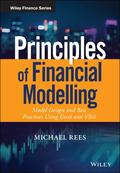Principles of Financial Modelling
Model Design and Best Practices Using Excel and VBA
Wiley Finance Series

1. Auflage Mai 2018
544 Seiten, Hardcover
Praktikerbuch
Kurzbeschreibung
Financial Modelling in Practice covers the full spectrum of financial modelling tools and techniques to provide practical skills grounded in real-world scenarios. This second edition has been significantly updated to align with the latest version of Excel and the current financial modelling climate, including new guidance on sensitivity analysis as a model design tool and risk analysis as an extension of sensitivity analysis. The companion website provides access to worked examples and pre-formatted spreadsheets to facilitate learning and implementation, and the strong emphasis on practical solutions allows direct real-world application.
* Utilize Excel at a more advanced level, including VBA modelling
* Learn unique tips and hints for data manipulation and analysis
* Understand financial statement modelling for valuation
* Master simulation, risk modelling and optimization
For practical instruction, robust technique and clear presentation, Financial Modelling in Practice is the premier guide to real-world financial modelling from the ground up.
The comprehensive, broadly-applicable, real-world guide to financial modelling
Principles of Financial Modelling - Model Design and Best Practices Using Excel and VBAcovers the full spectrum of financial modelling tools and techniques in order to provide practical skills that are grounded in real-world applications. Based on rigorously-tested materials created for consulting projects and for training courses, this book demonstrates how to plan, design and build financial models that are flexible, robust, transparent, and highly applicable to a wide range of planning, forecasting and decision-support contexts. This book integrates theory and practice to provide a high-value resource for anyone wanting to gain a practical understanding of this complex and nuanced topic. Highlights of its content include extensive coverage of:
* Model design and best practices, including the optimisation of data structures and layout, maximising transparency, balancing complexity with flexibility, dealing with circularity, model audit and error-checking
* Sensitivity and scenario analysis, simulation, and optimisation
* Data manipulation and analysis
* The use and choice of Excel functions and functionality, including advanced functions and those from all categories, as well as of VBA and its key areas of application within financial modelling
The companion website provides approximately 235 Excel files (screen-clips of most of which are shown in the text), which demonstrate key principles in modelling, as well as providing many examples of the use of Excel functions and VBA macros. These facilitate learning and have a strong emphasis on practical solutions and direct real-world application.
For practical instruction, robust technique and clear presentation, Principles of Financial Modelling is the premier guide to real-world financial modelling from the ground up. It provides clear instruction applicable across sectors, settings and countries, and is presented in a well-structured and highly-developed format that is accessible to people with different backgrounds.
About the Author xxvii
About the Website xxix
PART ONE Introduction to Modelling, Core Themes and Best Practices 1
CHAPTER 1 Models of Models 3
CHAPTER 2 Using Models in Decision Support 7
CHAPTER 3 Core Competencies and Best Practices: Meta-themes 15
PART TWO Model Design and Planning 23
CHAPTER 4 Defining Sensitivity and Flexibility Requirements 25
CHAPTER 5 Database Versus Formulae-driven Approaches 37
CHAPTER 6 Designing the Workbook Structure 47
PART THREE Model Building, Testing and Auditing 57
CHAPTER 7 Creating Transparency: Formula Structure, Flow and Format 59
CHAPTER 8 Building Robust and Transparent Formulae 79
CHAPTER 9 Choosing Excel Functions for Transparency, Flexibility and Efficiency 105
CHAPTER 10 Dealing with Circularity 117
CHAPTER 11 Model Review, Auditing and Validation 143
PART FOUR Sensitivity and Scenario Analysis, Simulation and Optimisation 153
CHAPTER 12 Sensitivity and Scenario Analysis: Core Techniques 155
CHAPTER 13 Using GoalSeek and Solver 163
CHAPTER 14 Using VBA Macros to Conduct Sensitivity and Scenario Analyses 171
CHAPTER 15 Introduction to Simulation and Optimisation 177
CHAPTER 16 The Modelling of Risk and Uncertainty, and Using Simulation 187
PART FIVE Excel Functions and Functionality 199
CHAPTER 17 Core Arithmetic and Logical Functions 201
CHAPTER 18 Array Functions and Formulae 217
CHAPTER 19 Mathematical Functions 229
CHAPTER 20 Financial Functions 243
CHAPTER 21 Statistical Functions 257
CHAPTER 22 Information Functions 299
CHAPTER 23 Date and Time Functions 307
CHAPTER 24 Text Functions and Functionality 313
CHAPTER 25 Lookup and Reference Functions 325
CHAPTER 26 Filters, Database Functions and PivotTables 355
CHAPTER 27 Selected Short-cuts and Other Features 387
PART SIX Foundations of VBA and Macros 395
CHAPTER 28 Getting Started 397
CHAPTER 29 Working with Objects and Ranges 413
CHAPTER 30 Controlling Execution 425
CHAPTER 31 Writing Robust Code 441
CHAPTER 32 Manipulation and Analysis of Data Sets with VBA 455
CHAPTER 33 User-defined Functions 473
Index 493
He has a Doctorate in Mathematical Modelling and Numerical Algorithms, and a B.A. with First Class Honours in Mathematics, both from Oxford University in the UK. He has an MBA with distinction from INSEAD in France. He also studied for the Certificate of Quantitative Finance, graduating top of the class for course work, and receiving the Wilmott Award for the highest final exam mark.
He has approximately 30 years' business and finance experience, in many sectors, including??oil, gas, energy and resources, private equity, health care, biotechnology, chemicals, construction, engineering, and insurance.


